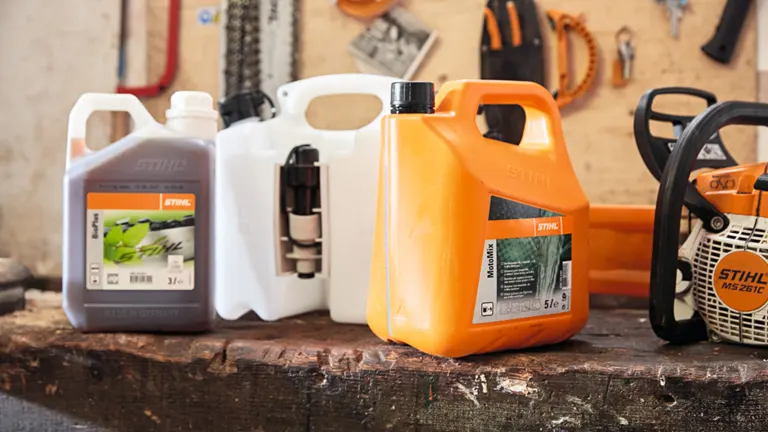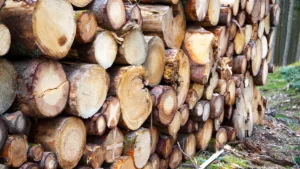What is the Fuel Mixture for a STIHL Chainsaw?
- February 7, 2024
- 2 comment
Maintaining your STIHL Petrol Chainsaw involves understanding the intricacies of its fuel mixture—a precise blend of petrol and engine oil crucial for its performance and longevity. In this comprehensive guide, we delve into the specifics of preparing the right fuel mixture, selecting appropriate ingredients, and employing best practices for mixing, refueling, and ensuring the enduring operation of your Chainsaw.
The Right Fuel & Oil Ratio for Your STIHL Petrol Chainsaw
Properly fueling your STIHL Chainsaw is not just about keeping it running; it’s about safeguarding its longevity, efficiency, and overall health. Utilizing an incorrect fuel mixture isn’t a mere oversight—it can lead to catastrophic engine issues such as piston seizure, excessive wear on crucial components, and a significantly shortened lifespan for your chainsaw. Therefore, understanding and adhering to the recommended fuel and oil ratio is not just recommended, it’s imperative.

For STIHL Chainsaws, the prescribed fuel mixture ratio is 1:50. This translates to mixing 1 part oil with 50 parts petrol. To put it into perspective, for every liter of petrol, you should mix in 20 ml of STIHL 2-Stroke Engine Oil.
Here’s a helpful table to calculate the stihl chainsaw gas mixture:
| Fuel Container Size (L) | Quantity of Fuel (L) | Quantity of STIHL 2-Stroke Oil (mL) |
|---|---|---|
| 1 | 1 | 20 |
| 2 | 2 | 40 |
| 3 | 3 | 60 |
| 5 | 5 | 100 |
| 10 | 10 | 200 |
| 20 | 20 | 400 |
Note: STIHL containers accommodate the extra 20 or 40 ml of oil.
Why is this ratio so critical?
- This specific ratio ensures optimal lubrication of your chainsaw’s engine. It reduces friction between moving parts, preventing overheating and wear.
- The right oil in the correct proportion supports the engine’s performance, ensuring it runs smoothly and efficiently.
- Properly mixed fuel helps in minimizing emissions, making your chainsaw more environmentally friendly and compliant with emission standards.
Using Non-STIHL Oils
While STIHL recommends using its own brand of 2-Stroke Engine Oil to guarantee the best performance and protection for your chainsaw, you might find yourself in situations where you need to use an alternative brand. In such cases:
- Different brands might have slightly different formulations. Ensure you follow the mixing instructions provided by the oil manufacturer to maintain the optimal 1:50 ratio.
- Regardless of the brand, ensure the oil is TC classified. This classification indicates that the oil is specifically formulated for 2-stroke engines and meets the minimum performance standards.
Using the Right Ingredients in Your Fuel Mix
Crafting the perfect fuel mix for your STIHL Chainsaw involves more than just combining oil and petrol; it’s about selecting the right type of each component to ensure optimal performance, longevity, and reliability of your equipment.

Here’s how you can make sure you’re using the best possible ingredients in your fuel mix.
What Type of Petrol Should I Use?
Your chainsaw’s performance is directly influenced by the quality of petrol you use. Here’s what you need to know about selecting the right type:
- Ensure the petrol you use has a minimum octane rating of 90 RON. This rating ensures that the fuel is resistant enough to pre-ignition or ‘knocking,’ which can be detrimental to your engine.
- In regions like New Zealand, where petrol is commonly available in 95/98 RON, opting for these higher-rated fuels is beneficial. They provide a buffer against potential engine knocking and are designed to ensure your chainsaw runs smoothly and efficiently.
What Type of Engine Oil Should I Use?
The engine oil in your fuel mix plays a pivotal role in lubricating the moving parts of your chainsaw’s engine, preventing wear and tear, and ensuring smooth operation. Here’s how to choose the right one:
- Choose High-Quality, TC-Classified 2-Stroke Engine Oils: These oils are specifically designed for two-stroke engines like the one in your STIHL Chainsaw. The TC classification is your assurance that the oil meets the necessary performance and lubrication standards.
- Freshness Matters: Always aim to use fresh fuel and oil. Over time, these substances can degrade, leading to reduced effectiveness and potential harm to your engine.
- STIHL 2-Stroke Engine Oil: Specially formulated for STIHL engines, this oil not only prolongs the life of your tool but also offers economic benefits by reducing consumption by half compared to other brands.
- STIHL HP Ultra Engine Oil: For even better performance and environmental responsibility, consider STIHL HP Ultra Engine Oil. It’s known for its complete combustion at operational temperatures, meaning it burns cleaner and leaves fewer residues. Additionally, its biodegradability and low Sulphur content make it an eco-friendlier choice.
Caution: It’s crucial to avoid inferior products. Using low-quality petrol or oil can lead to significant engine damage, including harm to the engine, sealing rings, and fuel tank. These damages are not just costly to repair but can also compromise the safety and efficiency of your chainsaw.
Mixing and Refueling
Properly mixing and refueling your STIHL Chainsaw are crucial steps in ensuring its optimal performance and longevity.

Here’s a detailed guide on how to mix your fuel correctly and refuel your chainsaw safely and efficiently.
How to Mix Fuel for Your Chainsaw
Creating the perfect fuel mix is not just about measuring; it’s about using the right techniques and tools. Here’s the process:
- Use a container specifically designed for fuel mixing, like the STIHL Fuel Mixing Bottle or a standard 5 Litre Fuel Can. These containers are designed to handle and store fuel safely.
- Begin by pouring the correct amount of 2-stroke engine oil into the container. Adding oil first ensures that the petrol you add later helps to rinse all the oil out of the container, ensuring a thorough mix.
- After the oil, add the appropriate amount of petrol. The petrol will mix with the oil, helping to dilute and spread it evenly throughout the mixture.
- Once both components are in the container, seal it tightly. Shake the container vigorously to ensure that the oil and petrol mix thoroughly. This step is vital to prevent oil from separating and settling at the bottom.
- After shaking, be cautious when opening the container. Pressure can build up inside, especially in warm conditions or if left in the sun. Open the cap slowly to release pressure safely.
Checklist: Refueling Your Chainsaw
Refueling your chainsaw requires attention and care to prevent accidents and ensure the longevity of your equipment. Here’s a comprehensive checklist for a safe refueling process:
- Ensure there are no open flames, sparks, or smoking near your refueling area. Petrol fumes are highly flammable and can ignite easily.
- Refuel at least 3 meters away from where you intend to start and use the chainsaw. This distance helps to prevent any accidental ignition from the chainsaw’s own spark.
- Never refuel a hot engine. Always switch off the engine and allow it to cool down before refueling. This reduces the risk of petrol vapors igniting from a hot engine.
- Open the fuel cap slowly and carefully. This is to ensure that any built-up pressure is released gradually, preventing fuel from spraying out.
- Always refuel your chainsaw in a well-ventilated area. This practice prevents the accumulation of fumes and reduces the risk of inhalation or ignition.
- If you spill fuel on your clothing, it’s not just a matter of a mess—it’s a serious safety hazard. Change any clothing that has fuel on it immediately to avoid the risk of ignition on your person.
Tips for Ensuring the Longevity of Your Petrol Chainsaw
Maintaining your petrol chainsaw involves more than just regular cleaning and sharpening the chain. The way you handle, mix, and store your fuel can also have a significant impact on the longevity and performance of your machine.

Here are some essential tips to help ensure your petrol chainsaw serves you well for years to come:
- Avoid Storing 2-Stroke Fuel Mix for Over 30 Days: It’s crucial to mix fuel in quantities that will be used within a month. Fuel mixtures, particularly those for two-stroke engines, can deteriorate over time, leading to the degradation of additives and the formation of residue. This can negatively affect your chainsaw’s performance and longevity. If you foresee not using your chainsaw for a month or more, it’s best to empty the fuel tank and allow the engine to run until it stops. This approach ensures that old fuel doesn’t sit in the engine, potentially causing harm or reducing efficiency.
- Watch Out for Separation in Your Fuel Mix: Fuel mix separation is a common issue, especially with ethanol fuels, as they have a propensity to attract moisture from the air. This moisture can lead to the separation of oil and petrol, compromising the lubrication of your chainsaw’s engine and potentially leading to damage. It’s advisable to store your fuel mix in a manner that limits its exposure to air and moisture, ideally in a cool and dry place. Regular inspections of your fuel mix can also be beneficial. If you notice any signs of separation, such as layering or an unusual texture, it’s safest to dispose of the mix properly and prepare a fresh batch.
- Incorrect Fuel Mix: Using the incorrect fuel mix can have immediate and detrimental effects on your chainsaw’s engine. If you realize that the fuel mix in your chainsaw is not correct, avoid starting the engine. Starting the engine with the wrong mix can lead to severe damage almost instantly. The appropriate course of action is to drain all the incorrect fuel from the tank. Once the tank is emptied, refill it with the correct mix. If, after this, your chainsaw doesn’t start, the issue might lie with the spark plug. In such a case, remove the spark plug and inspect it. Clean the spark plug thoroughly or replace it if it’s beyond cleaning. This should resolve most start-up issues related to fuel mix errors.
Chainsaw Bar Lubrication
To maintain optimal lubrication, it’s recommended to check and top up the bar lube every time you refuel your chainsaw. This practice ensures that your chainsaw is always ready for operation with adequate lubrication. Typically, chainsaws are designed so that the fuel will deplete before the bar lube, ensuring that you don’t run out of bar lube while there’s still fuel to run the chainsaw. However, it’s a good habit to visually inspect and top up the bar lube regularly, especially during extended cutting sessions or when tackling particularly tough or dense materials.
FAQs
- Can I use automotive oil instead of 2-stroke engine oil for my STIHL Chainsaw?
Automotive oil is not recommended for 2-stroke engines like those in STIHL Chainsaws. 2-stroke engine oil is specifically formulated to mix properly with petrol and lubricate the engine effectively, whereas automotive oil is designed for separate lubrication systems and may not provide adequate protection, leading to potential damage. - How does altitude affect my STIHL Chainsaw’s fuel mixture?
At high altitudes, air density decreases, which can affect the fuel-air mixture in your chainsaw’s engine. It might be necessary to adjust the carburetor settings for optimal performance. Consult your STIHL manual or a professional if you’re operating at altitudes significantly higher than sea level. - Why is my chainsaw producing smoke, even with the right fuel mixture?
Smoke can indicate that the fuel mix is too rich in oil, or the air filter is clogged, restricting airflow and causing incomplete combustion. Check your fuel mix ratio and ensure that the air filter is clean and properly installed. - Can old petrol affect my chainsaw’s performance, and how can I tell if petrol is too old to use?
Yes, petrol can degrade over time, losing volatility and leaving behind residues that can clog the fuel system. If your petrol is more than a month old, it might be best to dispose of it properly and use a fresh batch. Old petrol might have a sour smell or darker color compared to fresh petrol. - Is it necessary to shake the fuel can each time before refueling the chainsaw?
Yes, it’s a good practice to gently shake the fuel can before each refuel to ensure the oil and petrol are well-mixed, especially if the can has been sitting for a while. This ensures consistent lubrication and engine performance. - How can I safely dispose of old or incorrect fuel mix?
Never dispose of petrol or oil in the drain, ground, or waterways. Check with your local waste management facilities for proper disposal guidelines. Some areas have dedicated hazardous waste disposal services for items like used petrol and oil. - What are the environmental implications of using a petrol chainsaw, and how can I minimize them?
Petrol chainsaws emit exhaust gases that can be harmful to the environment. To minimize the impact, use biodegradable bar oil, maintain your chainsaw regularly to ensure it’s running efficiently, and consider using high-quality, low-emission 2-stroke oil.
We hope this guide has been helpful in understanding the nuances of fuel mixture and maintenance for your STIHL Chainsaw. If you have any tips, personal experiences, or questions about chainsaw care, we’d love to hear from you! Feel free to share your thoughts in the comments below. Your insights not only enrich our community’s knowledge but also help fellow chainsaw enthusiasts in their journey of mastering this powerful tool. Happy sawing!

David Murray
Forestry AuthorI'm David Murry, a forestry equipment specialist with a focus on chainsaw operation. With over 13 years of experience, I've honed my skills in operating and maintaining a wide range of machinery, from chainsaws to log splitters. My passion for the outdoors and commitment to sustainable forestry drive my work, which emphasizes safety, efficiency, and staying updated with industry advancements. Additionally, I'm dedicated to sharing my expertise and promoting environmental awareness within the forestry community.













Thank you for your insight on how to maintain Stihl . I love the machine and use it in my forestry operations.
Paul keino
February 12, 2024 5:20 amCheers!
David Murray
February 12, 2024 5:27 am